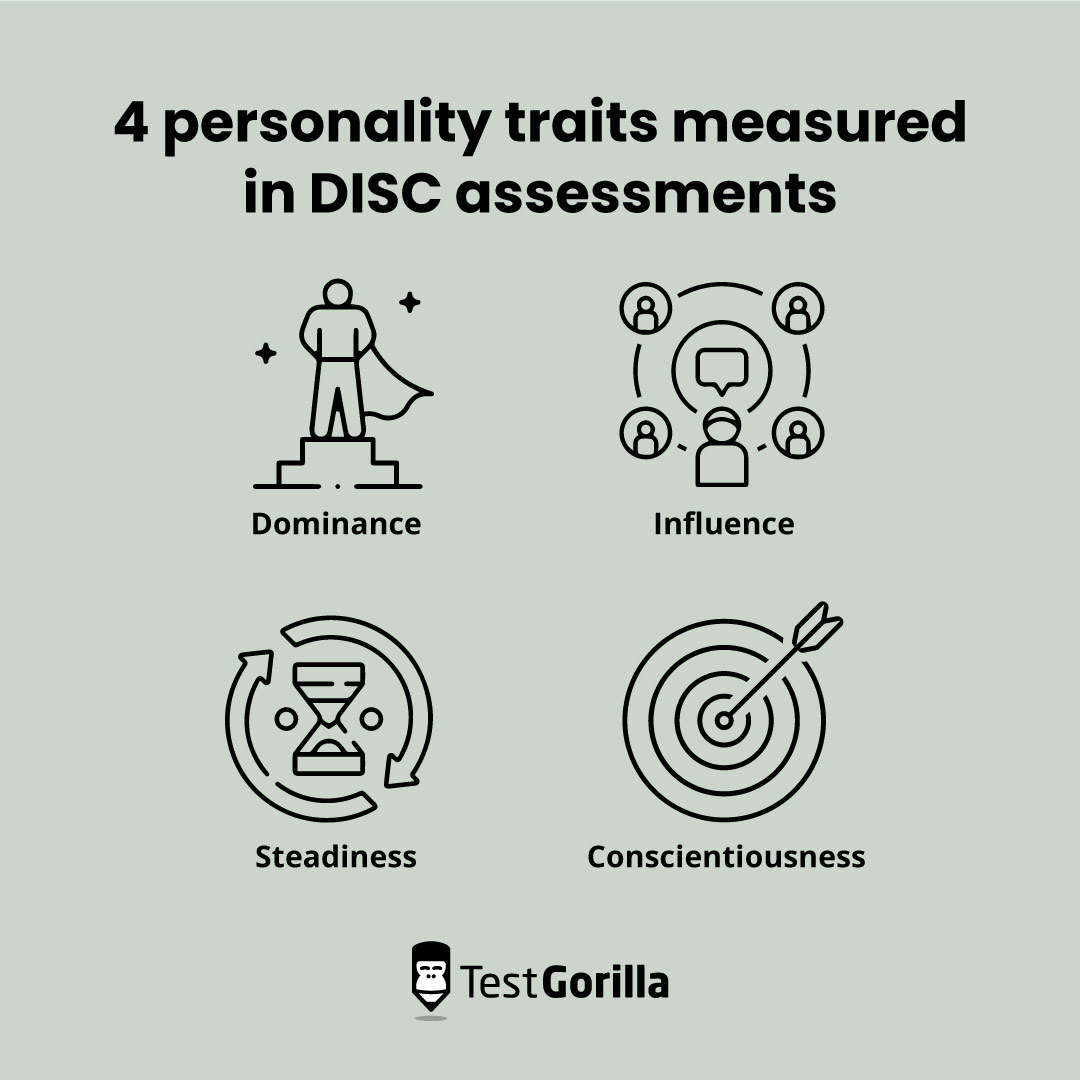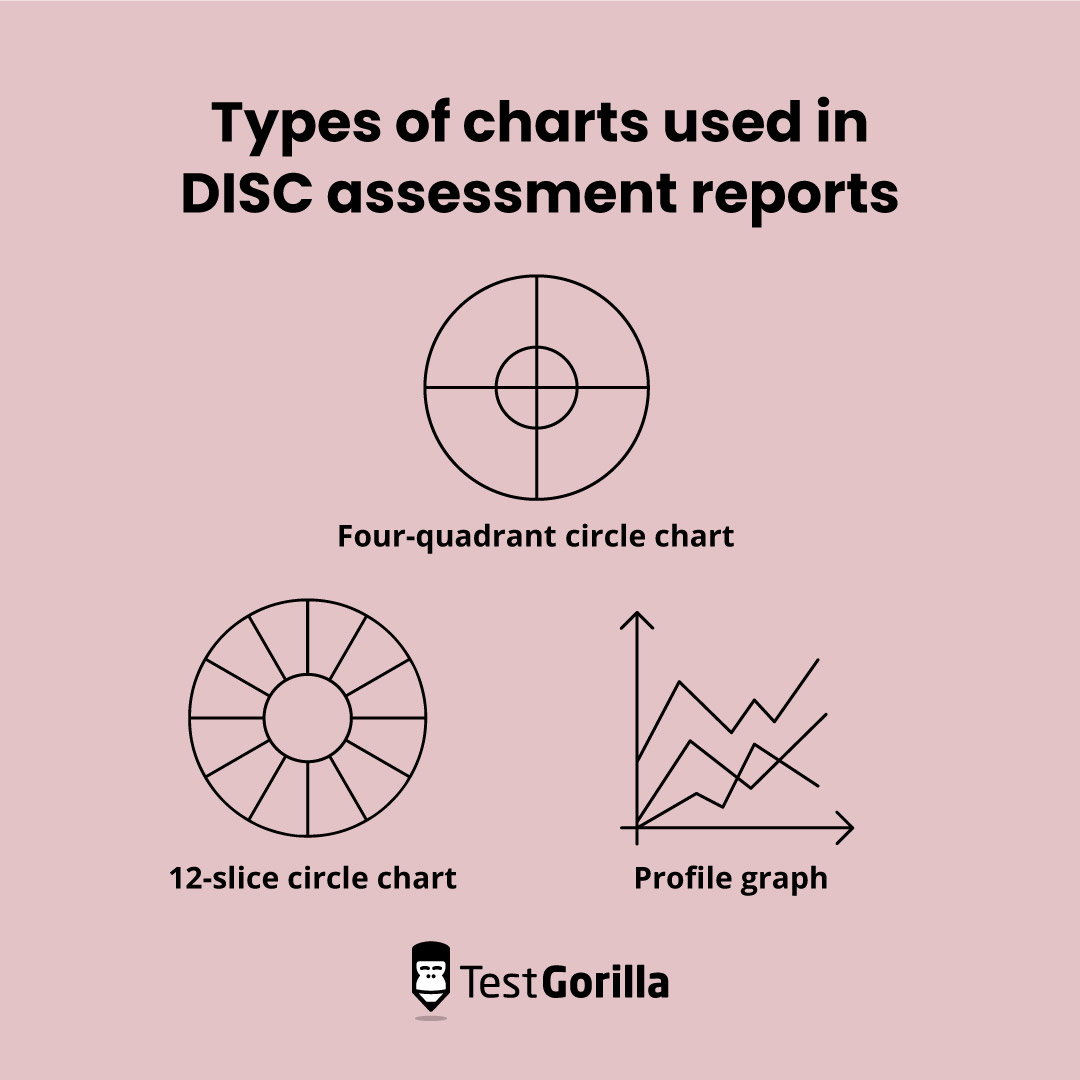A DISC assessment can help you understand your employees’ personalities and better manage them at work. You can also use DISC assessments to evaluate job applicants’ personalities when hiring for an open role.
However, DISC assessment results can be confusing to interpret if you haven’t used this type of test before. It’s important to understand the personality traits the test measures and how they are quantified in the chart.
In this guide, we’ll explain how to interpret the DISC assessment chart and take a closer look at the four personality traits the DISC assessment evaluates.
Table of contents
What is a DISC assessment?
A DISC assessment is a type of personality test that measures four personality traits:
Dominance
Influence
Steadiness
Conscientiousness
It involves a series of 20-75 statements and asks test-takers to qualify how well each of those statements applies to them.
DISC assessments are often used by companies to evaluate employees and job candidates. The personality traits this test measures directly relate to how individuals perform at work. Senior staff can use the insights from a DISC assessment to better manage their employees and organize them into teams. Learn more: 8 benefits of using the DISC test in your hiring process
Understanding the four DISC personality traits
Let’s take a closer look at what characterizes each personality trait the DISC assessment measures.
Dominance
The dominance personality trait measures how assertive an employee or candidate is.
Individuals who have high dominance scores tend to be confident in themselves and direct in their communications with others. They are often highly motivated by goals and will do whatever it takes to achieve them.
Dominant individuals are also comfortable making decisions quickly and committing to a plan. They typically work well under pressure.
These individuals may be strong leaders, but they don’t always get along well with others. Dominant individuals can be demanding or overly aggressive in the pursuit of achieving goals.
Influence
The influence personality trait measures how well an employee works with others.
A high score indicates that individuals are social and typically enjoy working in collaborative groups. They are enthusiastic and bring together ideas from multiple people. This can make influential individuals very useful for brainstorming sessions.
Influential individuals can be very strong leaders since they are good at encouraging others to follow them. They also try to avoid conflict, enabling them to broker compromises within teams.
Influential individuals may be overly emotional or prone to overpromising results. Their tendency to avoid conflict can also make it difficult for them to pursue solutions to problems that will make others unhappy.
Steadiness
The steadiness personality trait measures how reliable an employee is in their personality, actions, and decision-making.
Steady individuals are highly dependable and usually patient and empathetic. They are often strong team members because they can be relied on to work effectively and in concert with the rest of the team.
Their reliability also enables them to build strong relationships with colleagues. They can make good leaders since they like to build consensus. However, they often don’t like to be in the position of making decisions on their own.
Individuals who score highly for steadiness tend to have well-defined routines. They may be resistant to change and need a lot of time to adapt to new situations.
Conscientiousness
The conscientiousness personality trait measures how analytical and detail-oriented an employee is.
Conscientious individuals love to dive into the weeds and draw attention to the details that others might miss. They take pride in accuracy and are often highly organized in their work.
Conscientious employees are also excellent problem-solvers. They can be objective when colleagues are emotional, although this can also give them the appearance of acting aloof.
These individuals can sometimes get stuck on the finer details and have a hard time letting go of small issues. Conscientious individuals also don’t like the unknown, which can make them somewhat risk-averse.
Interpreting DISC assessment results
A DISC assessment report will show the degree to which an employee exhibits dominance, influence, steadiness, and conscientiousness. Based on their responses during the DISC assessment, each employee receives a score from 0 to 100 for each personality trait.
Very few people will score 100 for one personality trait and 0 for the others. Instead, most people have a mix of personality traits. They may be a combination of dominant and conscientious, for example, or a mix of dominant, influential, and steady.
Most DISC assessment reports will provide a simple summary of an employee’s or candidate’s personality type, often in abbreviations such as “D” (dominant) or “SC” (steady and conscientious).
Our guide to how to interpret DISC assessment results explains personality type combinations in more detail.
Understanding DISC assessment charts
DISC assessment reports use charts to visualize an individual’s score for each of the four traits. There are several types of charts that you may see used in the test report.
Four-quadrant circle chart
DISC assessment results are most commonly displayed in a circle chart. It’s split into four quadrants, each representing one of the four personality traits.
Shading in each quadrant indicates the degree to which an individual exhibits that personality trait. Most individuals will have at least some shading in each quadrant, but one or two quadrants may have significantly more shading than the others. This indicates that the employee most strongly exhibits those personality traits.
Many DISC charts also have a dot somewhere in the circle. This dot represents the individual’s average score across the traits. The closer the dot is to the outer edge of the circle, the more strongly an individual exhibits the personality trait of the quadrant the dot lies in.
12-slice circle chart
Some DISC assessment charts are divided into 12 slices instead of four. These 12 slices offer a more nuanced look at personality combinations. For example, the three slices in the dominance quadrant will represent scores for dominance, dominance-influence, and dominance-conscientiousness.
The 12-slice chart is especially useful because each slice is correlated with specific personality types. They are categorized as follows:
Dominance personality types:
D: Dominant
DC: Independent
DI: Efficient
Influence personality types:
I: Influential
ID: Friendly
IS: Enthusiastic
Steadiness personality types:
S: Steady
SI: Thoughtful
SC: Persistent
Conscientiousness personality types:
C: Conscientious
CD: Cooperative
CS: Sensitive
As for the four-quadrant circle chart, each slice will be shaded according to an individual’s score for each trait or trait combination. A dot will mark the trait or combination that best characterizes that individual.
Profile graphs
DISC profile graphs include a series of three line charts. Each chart has the four personality traits across the X-axis and scores for each trait on the Y-axis. The higher an individual scores for a trait in the DISC assessment, the higher the line will be.
The first chart shows an individual’s “adapting profile”. This reflects an individual’s DISC personality profile when that person is acting in public.
The trait scores for this chart are based on a subset of the DISC assessment statements that ask about how a person wants to be seen by others. For example, the test might ask whether an individual agrees with the statement, “People think of me as a good listener.”
A person’s adapting profile can change over time based on changes in their work environment or as they age.
The second chart is the “natural profile”. It indicates an individual’s core personality profile, which typically takes over when they are on their own or acting under stress.
The trait scores for this chart are based on a subset of the DISC assessment statements that ask how a person sees themselves. For example, the test might ask whether an individual agrees with the statement, “I like to keep things tidy.”
A person’s natural profile will usually remain consistent over time.
The third chart is an overall profile that shows an individual’s combined public and private personality. It’s based on their answers to all of the DISC assessment questions rather than a subset.
Employees may not exhibit the personality profile displayed in this chart very frequently since they will usually oscillate between their adapting and natural personalities.
How to apply DISC assessment results at work
Evaluating your employees’ DISC personality profiles can result in meaningful gains at work.
First, managers can use DISC assessment results to better understand and support their employees.
An employee who has an influential personality, for example, might work best in a collaborative team. On the other hand, an employee who has a conscientious personality might feel most comfortable working on a highly detail-oriented project.
Managers can also consult employees’ DISC personality profiles when deciding how to organize employees into teams. A team might benefit from having several employees with steady personalities and one employee with an influential personality. A team with multiple employees with dominant personalities could be a recipe for conflict.
You can also use DISC assessments when evaluating applicants for an open job role. If the job requires a lot of attention to detail, for example, you might prefer a candidate who has a conscientious personality type. If the job requires a candidate to work within a team, you might look for candidates who score highly for influence or steadiness.
Similarly, you can use DISC assessments when considering whether to promote an employee. Some personality types, such as dominant and influential personalities, are better-suited for leadership roles than others.
Of course, DISC personality profiles shouldn’t be the only metric used for hiring and promotion decisions. But when all else is equal between two candidates, these personality assessments can provide helpful insights into how an individual might perform in a specific role. Recommended reading: Guide to DISC assessment costs
Conclusion
DISC personality assessments can help you better understand your employees and job applicants. You can use a DISC test to find the right candidate for a job or help managers support their employees and organize them into teams.
There are multiple types of DISC assessment charts, including four-quadrant and 12-slice circle charts and profile line graphs. Each chart style offers a different way to visualize the results of your DISC assessment and understand employees’ personality types.
You can offer DISC assessments to your employees at no cost using TestGorilla. Our Free plan gives you unlimited access to 10 of our most popular tests, including a DISC assessment.
Sign up today to learn more about your employees' and candidates’ personalities.
Related posts
Hire the best candidates with TestGorilla
Create pre-employment assessments in minutes to screen candidates, save time, and hire the best talent.
Latest posts
The best advice in pre-employment testing, in your inbox.
No spam. Unsubscribe at any time.

Hire the best. No bias. No stress.
Our screening tests identify the best candidates and make your hiring decisions faster, easier, and bias-free.
Free resources
This checklist covers key features you should look for when choosing a skills testing platform
This resource will help you develop an onboarding checklist for new hires.
How to assess your candidates' attention to detail.
Learn how to get human resources certified through HRCI or SHRM.
Learn how you can improve the level of talent at your company.
Learn how CapitalT reduced hiring bias with online skills assessments.
Learn how to make the resume process more efficient and more effective.
Improve your hiring strategy with these 7 critical recruitment metrics.
Learn how Sukhi decreased time spent reviewing resumes by 83%!
Hire more efficiently with these hacks that 99% of recruiters aren't using.
Make a business case for diversity and inclusion initiatives with this data.



















